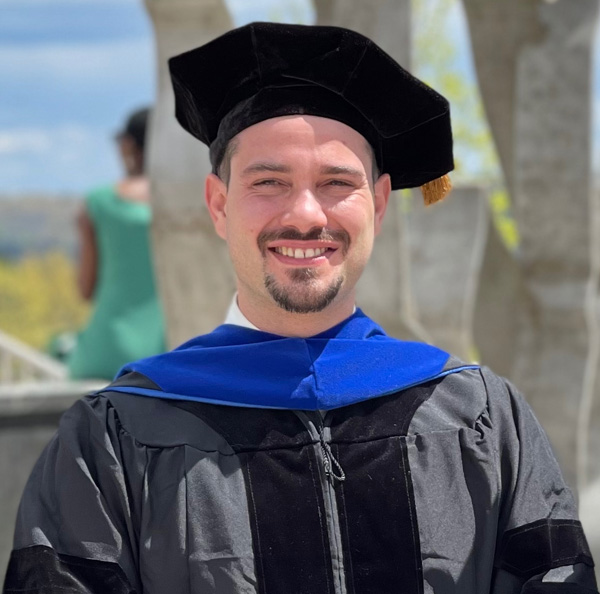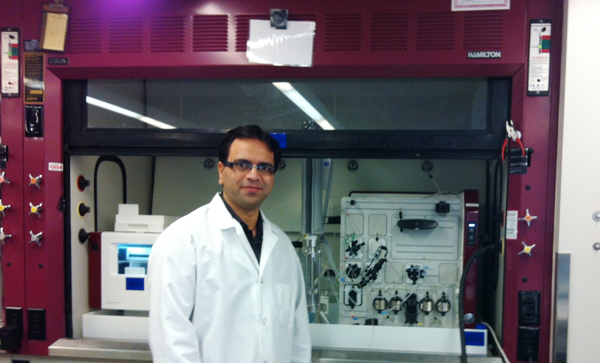Alumni
Christopher Ryan (PhD, 2023)

I am currently working in Cambridge MA at 1 Kendall Square as a Scientist at a stealth-stage biotech startup. I was one of the first 5 employees to join the company in the summer of 2023 and was heavily involved in establishing lab operations. Since then, I've worked towards developing in-house capabilities for the synthesis and purification of modified RNAs for R&D and PD applications.
Nikita Brodyagin (PhD, 2021)

I am the head of oligonucleotide operations at Korro Bio. At Korro, we focus on RNA editing using endogenous enzymatic machinery and synthetic oligonucleotides to edit the desired site. I oversee small high throughput synthesis as well as medium and large scales. We work with highly modified oligonucleotides that are designed to be specific to the target as well as stable in the presence of nucleases.
Julien Viel (PhD, 2021)

Since completing my PhD in 2021, I've continued work with nucleic acids as a scientist at Alnylam Pharmaceuticals. My current focus is in drug substance production, which has allowed me opportunities to continue learning while overcoming exciting challenges that remain in the RNA field.
Praveen Kumar Gajula (Postdoc, 2019-2020)

Praveen Kumar Gajula is currently working at TCG GreenChem, Inc. as a Senior Research Scientist-II in the department of process research and development.
Irina Novosjolova (Postdoc, 2015-2017)

Many azolylpurine derivatives have useful biological activity. They are used as agonists and antagonists of adenosine receptors and display useful levels of antiviral and anticancer activities. Several azolylpurine derivatives possess useful photophysical properties that can be successfully applied in biological chemistry. The aim of our research is to investigate new modified purine nucleoside analogues with azolyl moieties in the structure, to test their chemical reactivity, to screen photophysical and biological activity and to study their potential applications as materials in the OLED technologies. Recently found ability of 1,2,3-triazolyl ring to act as a good leaving group ensures us to investigate novel nucleophilic aromatic substitution reactions between 2,6-bis-(1,2,3-triazolyl)purine intermediates and C-, O-, Se-, N(sp2)- and P-nucleophiles. Furthermore, we develop synthetic use of azide-tetrazole tautomeric equilibrium of azidopurine derivatives and investigate conditions for C2- and C6-regioselectivity in the nucleophilic aromatic substitution reactions. When the compound library of differently substituted azolylpurine derivatives will be obtained, they will be screened for their anticancer activity and fluorescent properties.
Thomas Zengeya (PhD, 2013)

I am a Research Associate Director at Aro Biotherapeutics. Aro Biotherapeutics is a Philadelphia, PA based clinical stage biotechnology company pioneering the development of tissue-targeted genetic medicines with a platform based on a proprietary protein technology called Centyrins. Aro is developing Centyrin-oligonucleotide conjugate therapies that are meant to address challenges facing oligonucleotide-based medicines today: targeted delivery of oligonucleotides to extra-hepatic tissues. I oversee all of Aro's in-house oligonucleotide production for the discovery phases as well as work with outside suppliers to meet all of Aro's oligonucleotides needs as we advance our pipeline into the clinic.
Pankaj Gupta (Postdoc, 2009-2011)

I work as a Process development Scientist at Nitto Denko Avecia Inc. at Cincinnati, OH. I am responsible for the process development in Oligonucleotide synthesis from Proof of concept experimentation to developing manufacturing protocols towards technology transfer and large-scale manufacturing.
Selvam Chelliah (Postdoc, 2008-2011)
My medicinal chemistry group at Texas Southern University is actively working in design and synthesis of new chemical entities for anti-cancer activity.
